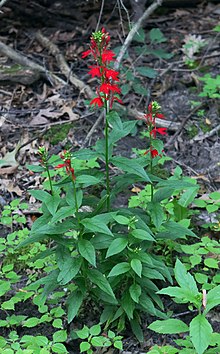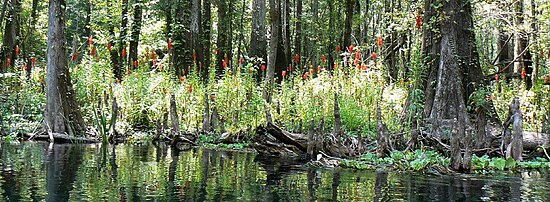bio.wikisort.org - Plant
Lobelia cardinalis, the cardinal flower (syn. L. fulgens), is a species of flowering plant in the bellflower family Campanulaceae native to the Americas, from southeastern Canada south through the eastern and southwestern United States, Mexico and Central America to northern Colombia.[2]
| Lobelia cardinalis | |
|---|---|
 | |
Conservation status | |
 Least Concern (IUCN 3.1) | |
| Scientific classification | |
| Kingdom: | Plantae |
| Clade: | Tracheophytes |
| Clade: | Angiosperms |
| Clade: | Eudicots |
| Clade: | Asterids |
| Order: | Asterales |
| Family: | Campanulaceae |
| Genus: | Lobelia |
| Species: | L. cardinalis |
| Binomial name | |
| Lobelia cardinalis | |
| Synonyms[1] | |
|
List
| |
Description
It is a perennial herbaceous plant that grows up to 1.2 m (4 ft) tall and is found in wet places, streambanks, and swamps. The leaves are up to 20 cm (8 in) long and 5 cm (2 in) broad, lanceolate to oval, with a toothed margin. The flowers are usually vibrant red, deeply five-lobed, up to 4 cm across; they are produced in an erect raceme up to 70 cm (28 in) tall during the summer to fall. Forms with white (f. alba) and pink (f. rosea) flowers are also known.[3] It grows along streams, springs, swamps, and in low wooded areas.[4]

Lobelia cardinalis is related to two other Lobelia species in to the Eastern United States, Lobelia inflata (Indian tobacco) and Lobelia siphilitica (great lobelia); all display the characteristic "lip" petal near the opening of the flower and the "milky" liquid the plant excretes. L. siphilitica has blue flowers and is primarily pollinated by bees, whereas L. cardinalis is red and is primarily pollinated by the ruby-throated hummingbird (Archilochus colubris).[5]

Etymology
It was introduced to Europe in the mid-1620s, where the name cardinal flower was in use by 1629, likely due to the similarity of the flower's color to the vesture of Roman Catholic Cardinals.[6]
Cultivation
In cultivation L. cardinalis requires rich, deep soil which remains reliably moist year-round. The cultivar 'Queen Victoria' has gained the Royal Horticultural Society's Award of Garden Merit.[7][8]
This plant is easily propagated by seed and dividing out the young plants which form around the older mature plants each year. Although the plant is generally considered a perennial, they may be short lived. They prefer moist soils in part shade.[9]
Medicinal and other uses
The Zuni people use this plant as an ingredient of "schumaakwe cakes" and used it externally for rheumatism and swelling.[10] The Penobscot people smoked the dried leaves as a substitute for tobacco. It may also have been chewed.[11]
Toxicity
As a member of the genus Lobelia, it is considered to be potentially toxic.[12] Symptoms of ingestion of large quantities include nausea, vomiting, diarrhea, salivation, exhaustion and weakness, dilation of pupils, convulsions, and coma.[13] The plant contains a number of toxic alkaloids including lobelamine and lobeline.[13]
References
- "Lobelia cardinalis L." Plants of the World Online. Board of Trustees of the Royal Botanic Gardens, Kew. 2017. Retrieved 2 December 2020.
- "Lobelia cardinalis". Germplasm Resources Information Network (GRIN). Agricultural Research Service (ARS), United States Department of Agriculture (USDA). Retrieved 21 December 2017.
- Missouriplants: Lobelia cardinalis
- "Lobelia cardinalis - Plant Finder". www.missouribotanicalgarden.org. Retrieved 2022-01-18.
- Caruso, C. M.; Peterson, S. B.; Ridley, C. E. (2003), "Natural selection on floral traits of Lobelia (Lobeliaceae): spatial and temporal variation", American Journal of Botany, 90 (9): 1333–40, doi:10.3732/ajb.90.9.1333, PMID 21659233
- Donaldson, C. (1999). Cardinal Flower – Spectacular Scarlet Blossoms That Hummingbirds Adore. Plants & Gardens News 14 (3). online at Brooklyn Botanic Garden. Accessed 23 May 2006.
- "RHS Plant Selector - Lobelia cardinalis 'Queen Victoria'". Retrieved 2 October 2020.
- "AGM Plants - Ornamental" (PDF). Royal Horticultural Society. July 2017. p. 61. Retrieved 25 March 2018.
- Frances Tenenbaum (2003). Taylor's Encyclopedia of Garden Plants. Houghton Mifflin Harcourt. pp. 244–. ISBN 0-618-22644-3.
- Stevenson, Matilda Coxe 1915 Ethnobotany of the Zuni Indians. SI-BAE Annual Report #30 (p. 56)
- Guédon, Marie-Françoise. Sacred Smudging in North America, Walkabout Press 2000
- Foster, Steven and James A. Duke. Eastern/Central Medicinal Plants. Peterson Field Guides, Houghton, Mifflin 1990 edn. ISBN 0-395-92066-3
- "Lobelia cardinalis". North Carolina State University Extension.
На других языках
- [en] Lobelia cardinalis
[es] Lobelia cardinalis
La cardenala encarnada[1] (Lobelia cardinalis) es una especie de planta de flores perteneciente a la familia Campanulaceae, es nativa de América, desde el sudeste de Canadá al sudeste de EE. UU., México y Centroamérica hasta el norte de Colombia.[2][ru] Лобелия пурпурная
Лобелия пурпурная, или Лобелия кардинальская, или Лобелия кровяно-красная (лат. Lobelia cardinalis) — прибрежно-водное растение рода Лобелия семейства Колокольчиковые (Campanulaceae), произрастающее на болотах Северной Америки.Другой контент может иметь иную лицензию. Перед использованием материалов сайта WikiSort.org внимательно изучите правила лицензирования конкретных элементов наполнения сайта.
WikiSort.org - проект по пересортировке и дополнению контента Википедии